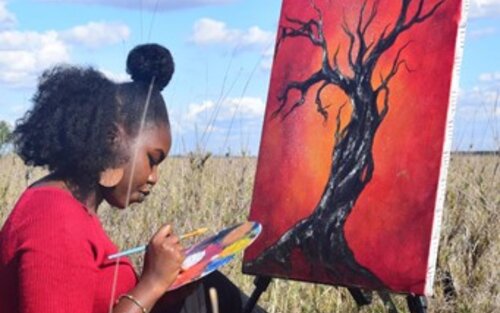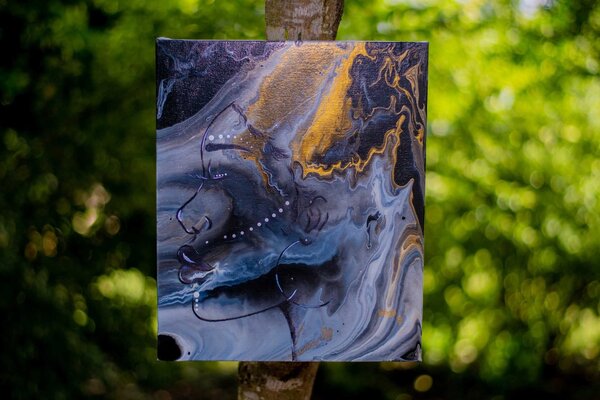Art is Therapy
Wanja Githua is an experimental Kenyan artist who tries a lot of different styles and ideas. She started painting 1.5 years ago to express what she feels and spread positive vibrations. In this article we interviewed Wanja about her art, her journey and emotions.

The Kenyan Artist Wanja (By Wanja)
“Art and mental health goes hand in hand. Art is a creative outlet, a positive way to use your time. In the process you learn more about yourself, you deal with your emotions and express yourself freely.” Wanja is a self-taught Kenyan artist. Art gives her freedom and a way to express herself.
The Start
Wanja never saw painting as something that she could pick up for the long run. But she says that “Binging YouTube painting tutorials was a sort of therapy’’ for her. After three months onto her new office job she felt like she did not have time for herself. “The place was toxic, labor intensive and very draining for me,” Wanja said. One day she walked into a restaurant with a huge lion painting on the wall. She turned to her friend, and said “I can paint this, why am I not doing this?” It was her “Aha moment.” Wanja went home and that was the beginning of her journey in art. She is a self-taught artist,and she learned almost everything she knows by watching YouTube videos and other artists.
Inspiration
‘Art gives me freedom” is Wanja’s answer to what motivates her to make art. She uses art as a way to express herself in “ways that words can’t.” Creating art which makes her happy and inspires others to create is her goal.
Wanja’s paintings are inspired by two subjects: women and nature. Women are Wanja’s biggest inspiration, and often the main subject of her work. Women have a delicate yet powerful spirit which inspires Wanja.
Nature is something Wanja grew up with, coming from a small village. Painting landscapes is her way to calm down, as it gives serenity and calmnes, working like therapy.
The Process
For Wanja, the process depends on the piece. Sometimes she creates different backgrounds because she hates plain white canvases that are staring back at her. From there, she picks a background and adds a female face to it and in that way she merges many different ideas to become one.
Because her art is a way to express her emotions and feelings, Wanja mostly works on impulse. Thinking of art as an extension of herself, all the experiences are brought together to create a single piece. ‘That is the beauty of art, you can't run away from who you are, it always comes up in your art’
When I asked Wanja about her personal style, Wanja says she is “so diverse, almost like it is not painted by the same person.” This might be related to how art makes her feel free. Wanja is not confined to one style of doing things, she is finding her language in art. Art can bring you closer to who you are and what you feel.
The Piece
“I want viewers to experience positive vibrations when looking at my work...I want them to be inspired to create, to go beyond, grow, be the best versions of themselves...I aim for my art to speak to the viewer and evoke emotions,” Wanja said.
“For an art piece to speak to you, you must listen to your heart, your inner voice. Ask yourself how the art makes you feel and be open to those emotions.” Wanja continues “allow the art to speak to you without judgment”
Mental Health
Looking at art activates a region of your brain that is involved in the experience of emotions. Art can bring up emotions and feelings. To be open to these emotions, Wanja says you should “allow the art to speak to you without judgement. Art is a creative outlet, a positive way to use your time.” Dealing with your emotions and being able to express yourself freely is what makes art and mental health go hand-in-hand. “Art is an extension of myself, every experience I have, the music I listen to, books I have read or places I have visited.” But this is not only true for Wanja. When you open up, let yourself be free and be true to your emotions, the art that you make or what you see in a piece will be a part of you. “Art is Therapy”
This is something Wanja also experienced personally. “Art saved me from a dark phase, so I am forever grateful” Wanja tells me. When she paints she does not think of anything else, she is consumed. Like meditation, art makes her disappear in her world, she is able to forget everything else and just disappear.
This all comes together in Wanja’s slogan: “More Art, more Life.”
“Art knows no boundaries or restrictions, it brings people together in ways that can only be felt.”
And she wants the readers to know “You can create in any way, you will know how, be happy. Work should be fun, life should be fun.”
